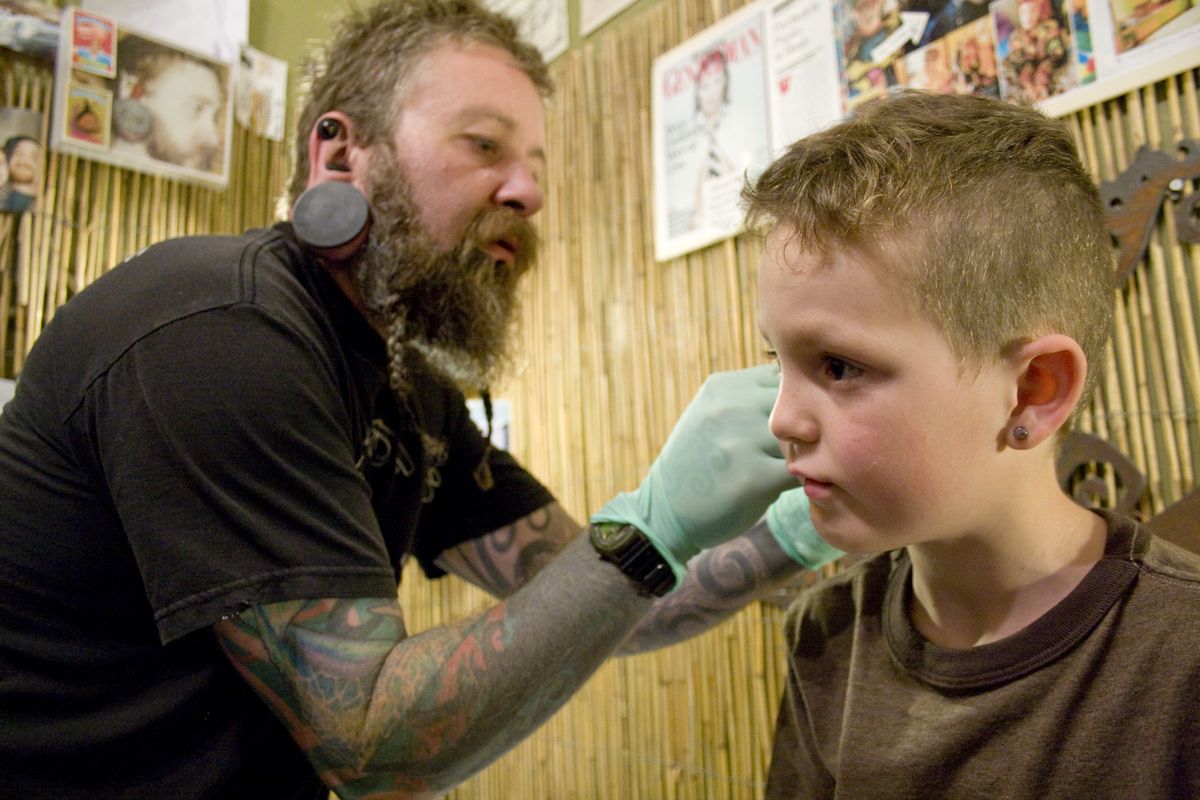Piercers seek basic rules, hope exotic won’t distract new panel

PORTLAND – Jon Guac burned a design into his skin with a candle and fork to prove a point during a dinner debate about whether branding was an art form. As a teenager, he carved “Iron Maiden” into his arm “for experimentation.”
Stories like his, along with graphic photos of extreme body modifications, encouraged the 2011 Oregon Legislature to establish a new Board of Body Art Practitioners. But body piercers worry that Internet photos of untrained hacks slicing bloody skin with scalpels will distract the board from writing rules for what they say is a bigger problem: licenses for common piercings like ears and belly buttons.
The board will oversee a hodge-podge of body arts, from tattoos and ear piercings to laser hair removal and designs burned into the skin. The governor’s office is looking for seven members: two body piercers, two tattooists, one electrologist, one health care provider and one member of the general public.
Legislators flinched during hearings, shocked by descriptions of genital piercings and an image found online of an anchor-shape freshly cut from the skin of a woman’s inner thigh.
“I thought I was pretty open-minded, but maybe I’m not,” Sen. Alan Bates, D-Ashland, said during an April hearing. He later said, “As a physician, some of these things I wouldn’t want to do in my office because I wouldn’t want to hurt them or risk infection.”
The new board has yet to be appointed, let alone make any decisions, but state leaders and piercers already have ideas about how it could reform regulations governing body art. Once rules are established, the Oregon Health Licensing Agency would come into play, since it’s responsible for enforcing standards and approving licenses based on the rules set by state boards.
Some legislators endorse the creation of specialty licenses for some body arts that verge on being a medical procedure and require advanced knowledge of anatomy. Others think high-risk procedures simply should be banned.
“If you regulate, that implies you will have clinical training,” Sen. Frank Morse, R-Albany, said in a hearing. “Where are you going to find clinical training to put double rings in the glans on a penis?”
Piercers say it’s a waste of resources to regulate the things that most frightened the Legislature. Very few people are interested in extreme body modifications and even fewer offer those services, often traveling the country to find enough clients. Regulations or bans would not slow the practices, just move them further underground, they argue.
Most piercers want to focus energy on reforms for the more commonplace piercing industry. They suggest changes to improve customer safety, thin the crowd of underqualified competitors and level the economic playing field for jewelry made from better materials.
Nearly 500 people are licensed body piercers in Oregon, a 30 percent increase from 2008. No specialized training is required to receive an Oregon piercing license.
Blake Perlingieri, owner of Nomad Precision Body Adornment and Tribal Museum, thinks it’s about time Oregon caught up on body piercing regulation.
Perlingieri began his apprenticeship at the opening of the world’s second piercing studio in 1988, co-founded the Association of Professional Piercers in 1994 and helped petition the California Legislature for sanitation standards that have been adopted widely in the U.S.
Perlingieri petitioned the Oregon Legislature in the 1990s to adopt training standards similar to a cosmetology license. He proposed issuing temporary licenses to apprentices until they have done thousands of piercings.
But it went nowhere, Perlingieri said. Fed up, he quit trying.
Desta Spence, owner of Adorn studios, hopes the new board is an opportunity to overcome old prejudices and has asked for a seat on it.
She wants to legitimize piercing licenses by having the standards increased to match consumers’ expectations of training, although she’s not yet sure how to do it. She also wants to set requirements for the materials used to make jewelry. Because most customers assume everyone with a license is safe, Spence said, they choose a piercer for the price, creating incentives for shops to sell cheap jewelry that could lead to infection and rejection.